key CHEVROLET ASTRO 1998 2.G Owners Manual
[x] Cancel search | Manufacturer: CHEVROLET, Model Year: 1998, Model line: ASTRO, Model: CHEVROLET ASTRO 1998 2.GPages: 414, PDF Size: 21.46 MB
Page 23 of 414
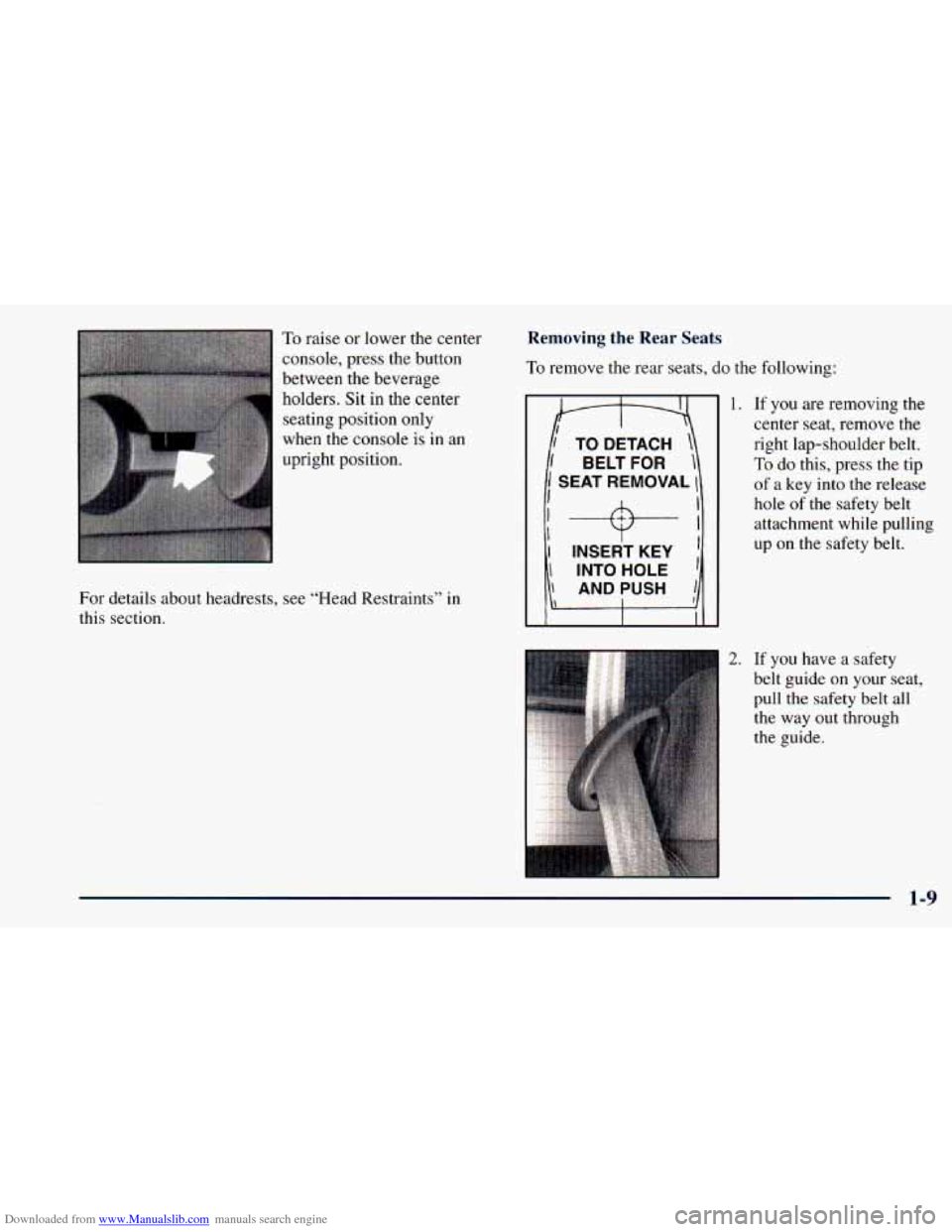
Downloaded from www.Manualslib.com manuals search engine To raise or lower the center
I console, press the button
between the beverage
holders. Sit in the center
seating position only
when the console is-in an
upright position.
For details about headrests, see “Head Restraints” in
this section.
Removing the Rear Seats
To remove the rear seats, do the following:
r7-7 I TO DETACH
I BELT FOR \ I
I SEAT REMOVAL 1
I
I -Q-.
I INSERT KEY
I INTO HOLE
1 ANDPUSH I I
1.
2.
If you are removing the
center seat, remove the
right lap-shoulder belt.
To do this, press the tip
of a key into the release
hole of
the safety belt
attachment while pulling
up
on the safety belt.
If you have
a safety
belt guide on your seat,
pull the safety
belt all
the way out through
the guide.
1-9
Page 40 of 414
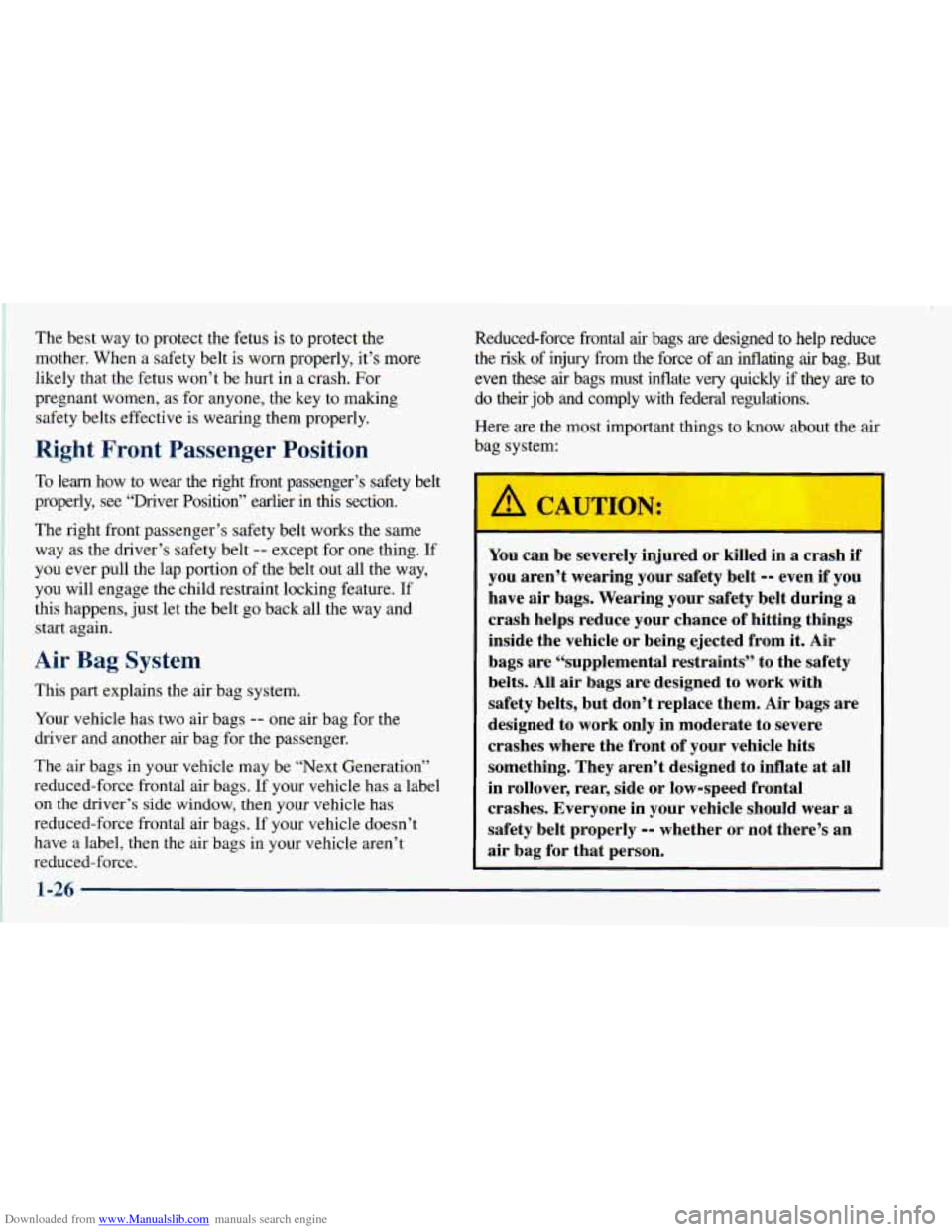
Downloaded from www.Manualslib.com manuals search engine The best way to protect the fetus is to protect the
mother. When a safety belt is worn properly, it’s more
likely that the fetus won’t be hurt in a crash. For
pregnant women, as for anyone, the key to making
safety belts effective is wearing them properly.
Right Front Passenger Position
To learn how to wear the right front passenger’s safety belt
properly, see “Driver Position” earlier in
this section.
The right front passenger’s safety belt works the same
way as the driver’s safety belt
-- except for one thing. If
you ever pull the lap portion of the belt out all the way,
you will engage the child restraint locking feature. If
this happens, just let the belt
go back all the way and
start again.
Air Bag System
This part explains the air bag system.
Your vehicle has two air bags
-- one air bag for the
driver and another air bag for the passenger.
The air bags in your vehicle may be “Next Generation”
reduced-force frontal air bags.
If your vehicle has a label
on the driver’s side window, then your vehicle has
reduced-force frontal air bags. If your vehicle doesn’t
have a label, then the air bags in your vehicle aren’t
reduced-force. Reduced-force frontal
air bags are designed to help reduce
the risk of injury
from the force of an inflating air bag. But
even these
air bags must inflate very quickly if they are to
do their job and comply with federal regulations.
Here are the most important things to know about the air
bag system:
‘ 3 CAUTION:
-
You can be severely injured or killed in a crash if
you aren’t wearing your safety belt -- even if you
have air bags. Wearing your safety belt during
a
crash helps reduce your chance of hitting things
inside the vehicle or being ejected from
it. Air
bags are “supplemental restraints’’ to the safety
belts. All air bags are designed to work with
safety belts, but don’t replace them. Air bags are
designed to work only in moderate to severe
crashes where the front of your vehicle hits
something. They aren’t designed to inflate
at all
in rollover, rear, side or low-speed frontal
crashes. Everyone in your vehicle should wear a
safety belt properly
-- whether or not there’s an
air bag for that person.
1-26
Page 45 of 414
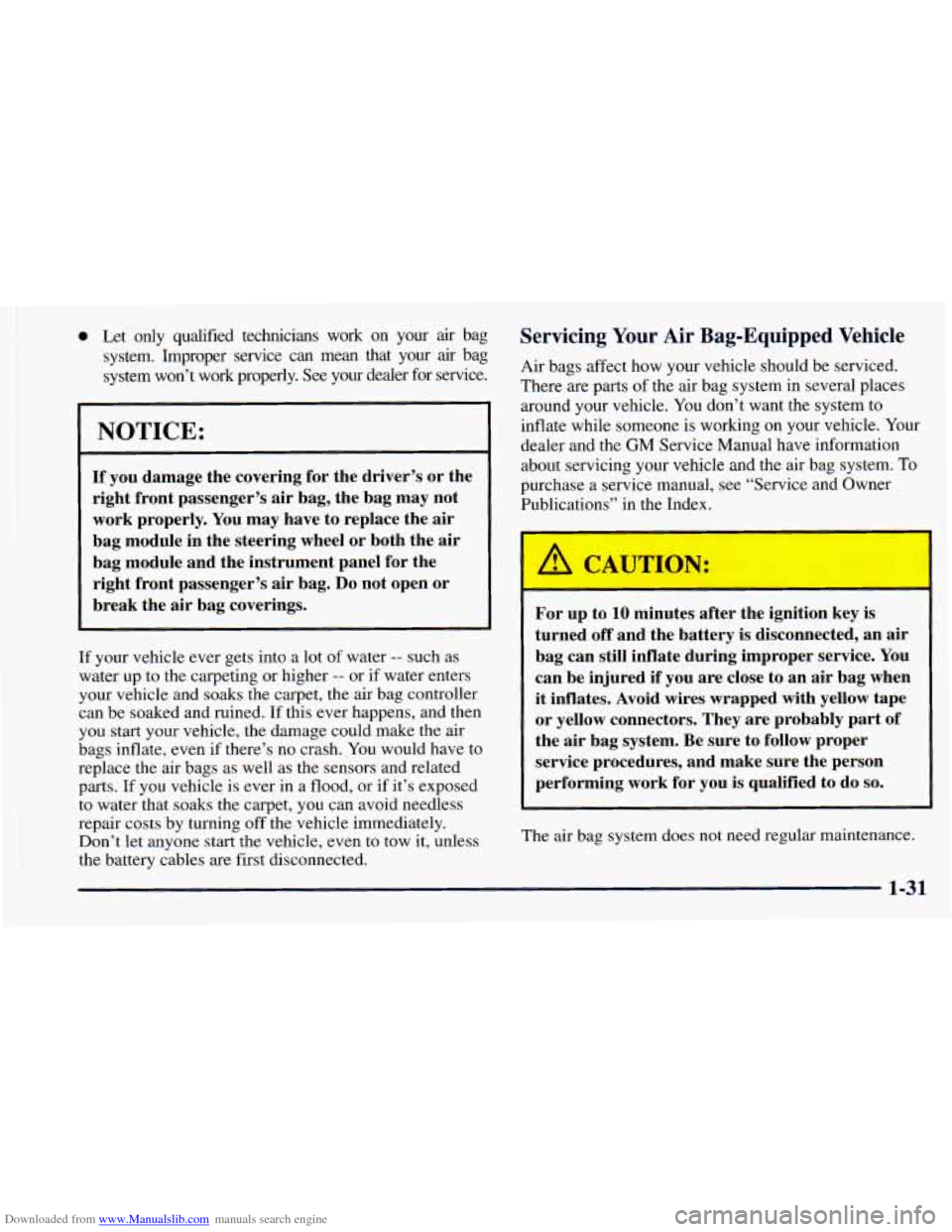
Downloaded from www.Manualslib.com manuals search engine 0 Let only qualified technicians work on your air bag
system. Improper service can mean that your
air bag
system won’t work properly. See your dealer for service.
NOTICE:
If you damage the covering for the driver’s or the
right front passenger’s air bag, the bag may not
work properly. You may have to replace the
air
bag module in the steering wheel or both the air
bag module and the instrument panel for the
right front passenger’s air bag.
Do not open or
break the air bag coverings.
If your vehicle ever gets into a lot of water
-- such as
water up to the carpeting or higher
-- or if water enters
your vehicle and
soaks the carpet, the air bag controller
can be soaked and ruined. If this ever happens, and then
you start your vehicle, the damage could make the air
bags inflate, even if there’s no crash. You would have to
replace the air bags as well as the sensors and related
parts. If you vehicle is ever in a flood, or if it’s exposed
to water that
soaks the carpet, you can avoid needless
repair costs by turning off the vehicle immediately.
Don’t let anyone start the vehicle, even to tow it, unless
the battery cables are first disconnected.
Servicing Your Air Bag-Equipped Vehicle
Air bags affect how your vehicle should be serviced.
There are parts of the air bag system in several places
around your vehicle. You don’t want the system to
inflate while someone is working on your vehicle. Your
dealer and the
GM Service Manual have information
about servicing your vehicle and the air bag system.
To
purchase a service manual, see “Service and Owner
Publications” in the Index.
For up to
10 minutes after the ignition key is
turned
off and the battery is disconnected, an air
bag can still inflate during improper service. You
can be injured if you are close to an air bag when
it inflates. Avoid wires wrapped with yellow tape
or yellow connectors. They are probably part of
the air bag system. Be sure to follow proper
service procedures, and make sure the person
performing work for you is qualified to
do so.
The air bag system does not need regular maintenance.
1-31
Page 85 of 414
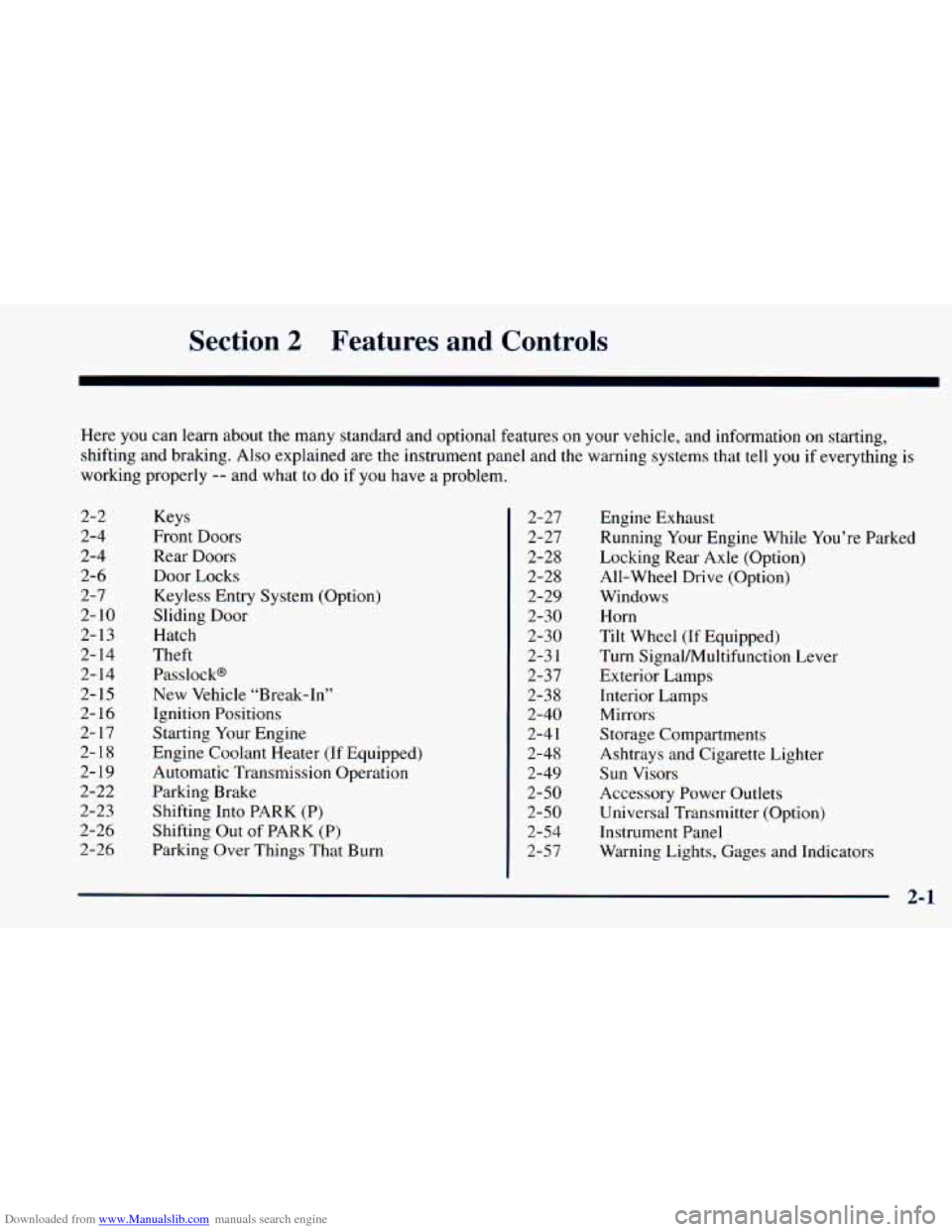
Downloaded from www.Manualslib.com manuals search engine Section 2 Features and Controls
Here you can learn about the many standard and optional features on your vehicle, and information on starting,
shifting and braking. Also explained are the instrument panel and the warning systems that
tell you if everything is
working properly
-- and what to do if you have a problem.
2-2 2-4
2-4
2-6
2-7
2-
10
2-13
2- 14
2- 14
2- 15
2- 16
2- 17
2- 18
2-
19
2-22
2-23
2-26
2-26 Keys
Front Doors
Rear Doors
Door Locks Keyless Entry System (Option)
Sliding Door
Hatch
Theft
Passlock@
New Vehicle “Break-In”
Ignition Positions
Starting Your Engine
Engine Coolant Heater
(If Equipped)
Automatic Transmission Operation
Parking Brake Shifting Into PARK (P)
Shifting Out of PARK (P)
Parking Over Things That Burn 2-27
2-
27
2-28
2-28
2-29
2-30 2-30
2-3
1
2-37
2-38
2-40
2-4
1
2-48
2-49
2-50
2-50 2-54
2-57 Engine Exhaust
Running
Your Engine While You’re Parked
Locking Rear Axle (Option)
All-Wheel Drive (Option)
Windows
Horn
Tilt Wheel (If Equipped)
Turn SignalhAultifunction Lever
Exterior Lamps
Interior Lamps
Mirrors
Storage Compartments
Ashtrays and Cigarette Lighter
Sun Visors
Accessory Power Outlets
Universal Transmitter (Option)
Instrument Panel
Warning Lights, Gages and Indicators
Page 86 of 414
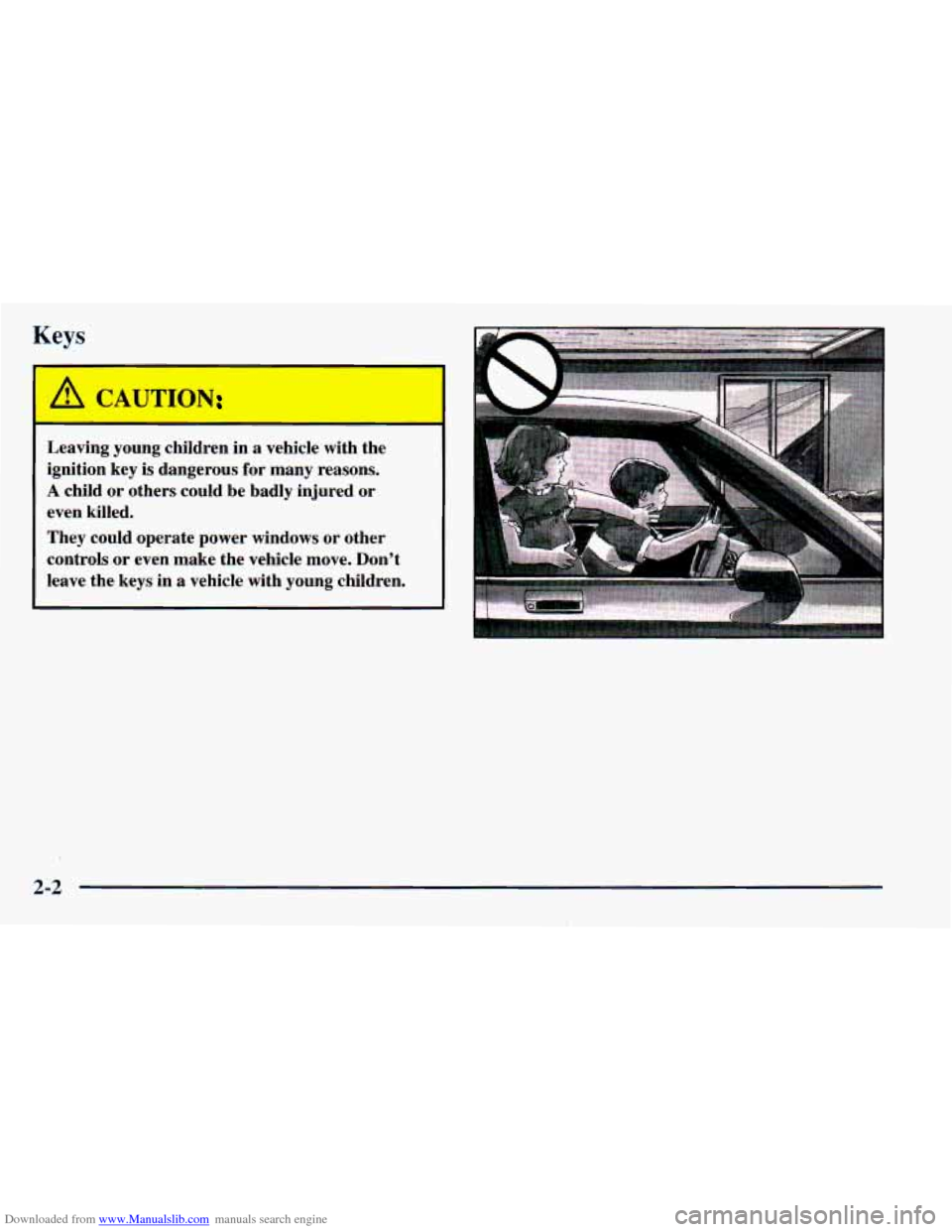
Downloaded from www.Manualslib.com manuals search engine Keys
I
A CAUTION
Leaving young children in a vehicle with the
ignition key
is dangerous for many reasons.
A child or others could be badly injured or
even killed.
They could operate power windows or other
controls or even make the vehicle move. Don't
leave the keys in a vehicle with young children.
2-2
Page 87 of 414
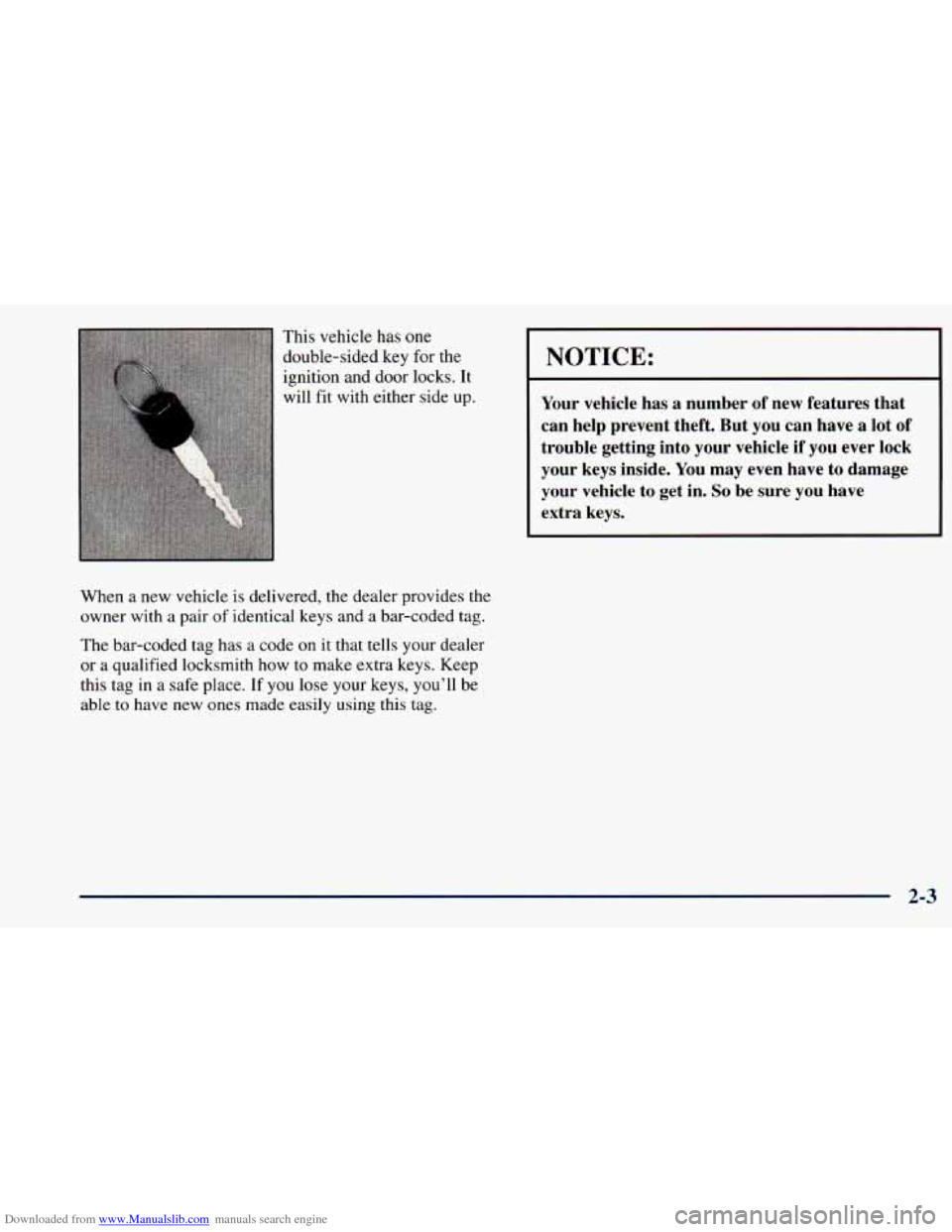
Downloaded from www.Manualslib.com manuals search engine This vehicle has one
double-sided key
for the
ignition and door locks. It
will fit with either side up.
When a new vehicle is delivered, the dealer provides the
owner with a pair
of identical keys and a bar-coded tag.
The bar-coded tag has a code on it that tells your dealer
or
a qualified locksmith how to make extra keys. Keep
this tag in a safe place.
If you lose your keys, you’ll be
able
to have new ones made easily using this tag.
NOTICE:
Your vehicle has a number of new features that
can help prevent theft. But you can have a lot of
trouble getting into your vehicle if you ever lock
your keys inside. You may even have to damage
your vehicle to get in.
So be sure you have
extra keys.
2-3
Page 90 of 414
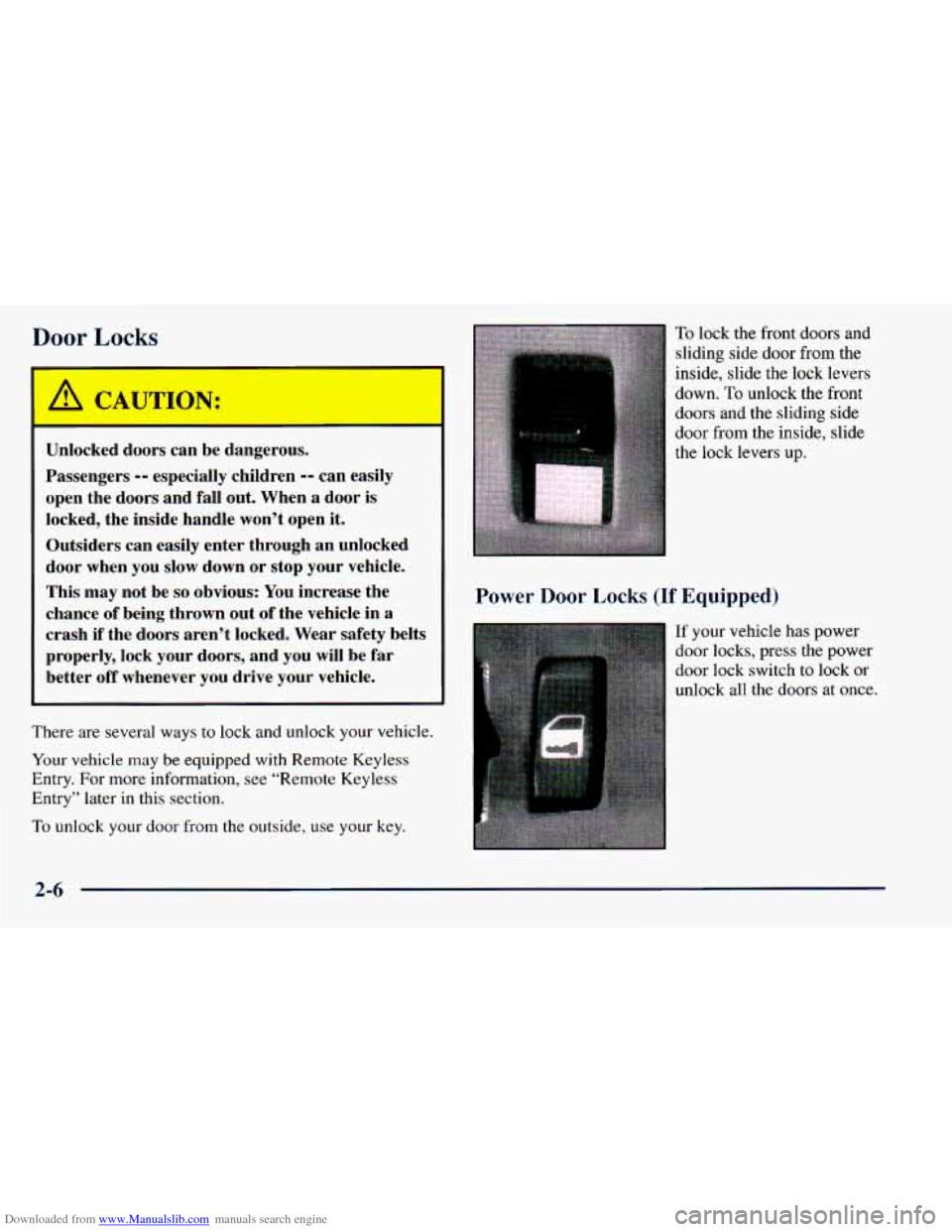
Downloaded from www.Manualslib.com manuals search engine Door Locks
I
I
Unlocked doors can be dangerous.
Passengers
-- especially children -- can easily
open the doors and fall out. When a door is
locked, the inside handle won’t open it.
Outsiders can easily enter through an unlocked
door when you slow down or stop your vehicle.
This may not be so obvious: You increase the
chance of being thrown out
of the vehicle in a
crash if the doors aren’t locked. Wear safety belts
properly, lock your doors, and you will be far
better
off whenever you drive your vehicle.
There are several ways to lock and unlock your vehicle.
Your vehicle
may be equipped with Remote Keyless
Entry. For more information, see “Remote Keyless
Entry” later in this section.
To unlock your door from the outside, use your key.
To lock the front doors and
sliding side door from the
inside, slide the lock levers
down. To unlock the front
doors and the sliding side
door from the inside, slide
the lock levers up.
Power Door Locks (If Equipped)
If your vehicle has power
door locks, press the power
door lock switch to lock
or
unlock all the doors at once.
2-6
Page 91 of 414
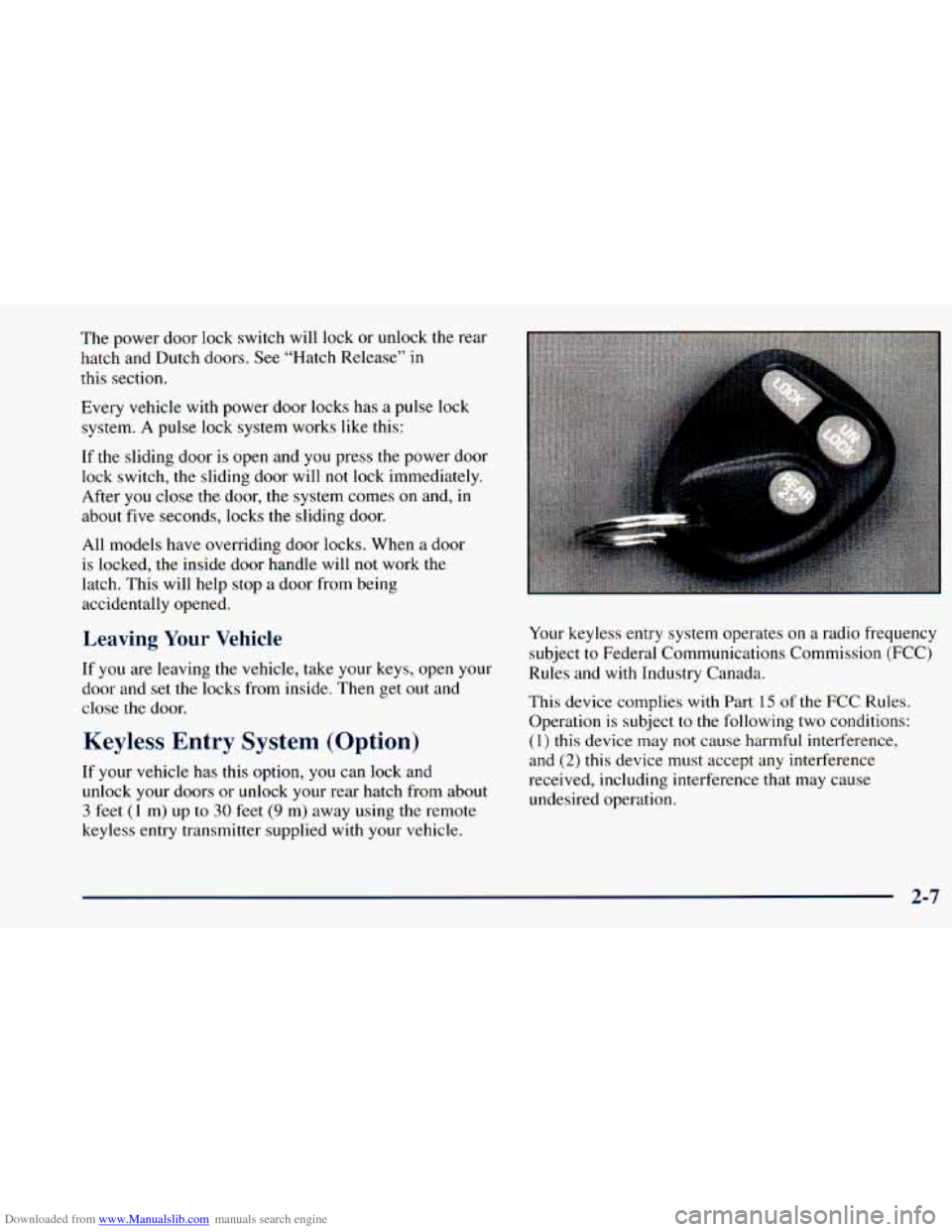
Downloaded from www.Manualslib.com manuals search engine The power door lock switch will lock or unlock the rear
hatch and Dutch doors. See “Hatch Release” in
this section.
Every vehicle with power door locks
has a pulse lock
system. A pulse lock
system works like this:
If the sliding door
is open and you press the power door
lock switch, the sliding door will not lock immediately.
After you close the door, the system comes
on and, in
about five seconds, locks the sliding door.
All models have overriding door locks. When a door
is locked, the inside door handle will not work the
latch. This will help stop a door from being
accidentally opened.
Leaving Your Vehicle
If you are leaving the vehicle, take your keys, open your
door and set the locks from inside. Then get out and
close the door.
Keyless Entry System (Option)
If your vehicle has this option, you can lock and
unlock your doors or unlock your rear hatch from about
3 feet (1 m) up to 30 feet (9 m) away using the remote
keyless entry transmitter supplied with your vehicle. Your
keyless entry system operates on a radio frequency
subject
to Federal Communications Commission (FCC)
Rules and with Industry Canada.
This device complies with Part
15 of the FCC Rules.
Operation is subject to
the following two conditions:
(1) this device may not cause harmful interference,
and
(2) this device must accept any interference
received, including interference that may cause
undesired operation.
2-7
Page 92 of 414
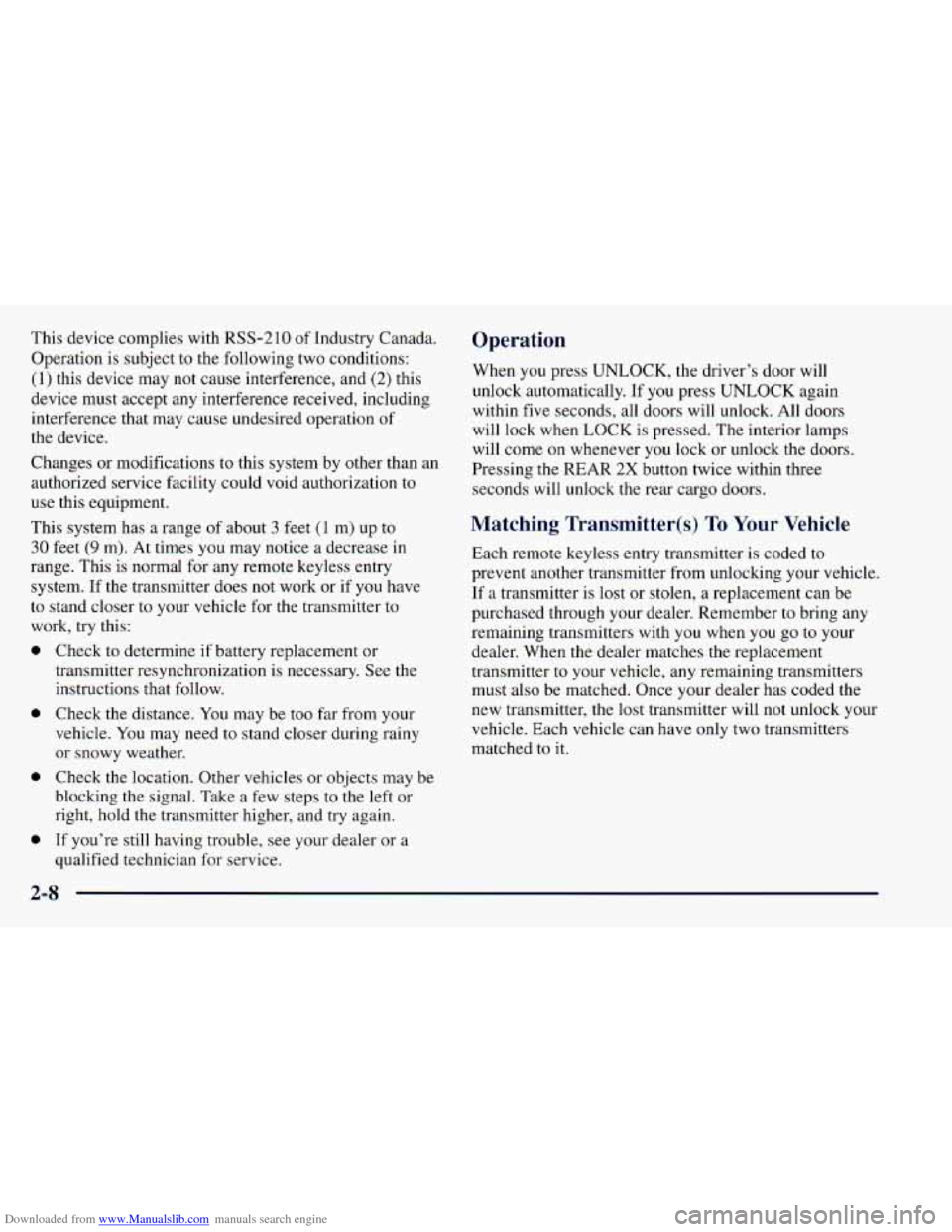
Downloaded from www.Manualslib.com manuals search engine This device complies with RSS-210 of Industry Canada.
Operation is subject to the following two conditions:
(1) this device may not cause interference, and
(2) this
device must accept any interference received, including
interference that may cause undesired operation of
the devict .
Changes or modifications to this system by other than an
authorized service facility could void authorization to
use this equipment.
This system has a range of about
3 feet (1 m) up to
30 feet (9 m). At times you may notice a decrease in
range. This is normal for any remote keyless entry
system. If the transmitter does not work or if
you have
to stand closer to your vehicle for the transmitter to
work,
try this:
Check to determine if battery replacement
or
transmitter resynchronization is necessary. See the
instructions that follow.
Check the distance. You may be too far from your
vehicle. You may need to stand closer during rainy
or snowy weather,
Check the location. Other vehicles or objects may be
blocking the signal. Take a few steps to the left or
right, hold the transmitter higher, and try again.
If you’re still having trouble, see your dealer or a
qualified technician for service.
Operation
When you press UNLOCK, the driver’s door will
unlock automatically. If you press
UNLOCK again
within five seconds, all doors will unlock. All doors
will lock when
LOCK is pressed. The interior lamps
will come on whenever you lock or unlock the doors.
Pressing the REAR
2X button twice within three
seconds will unlock the rear cargo doors.
Matching Transmitter(s) To Your Vehicle
Each remote keyless entry transmitter is coded to
prevent another transmitter from unlocking your vehicle.
If a transmitter is lost or stolen, a replacement can be
purchased through your dealer. Remember to bring any
remaining transmitters with you when you go to your
dealer. When the dealer matches the replacement
transmitter to your vehicle, any remaining transmitters
must also be matched. Once your dealer has coded the
new transmitter, the lost transmitter will not unlock your
vehicle. Each vehicle can have only two transmitters
matched to it.
2-8
Page 93 of 414
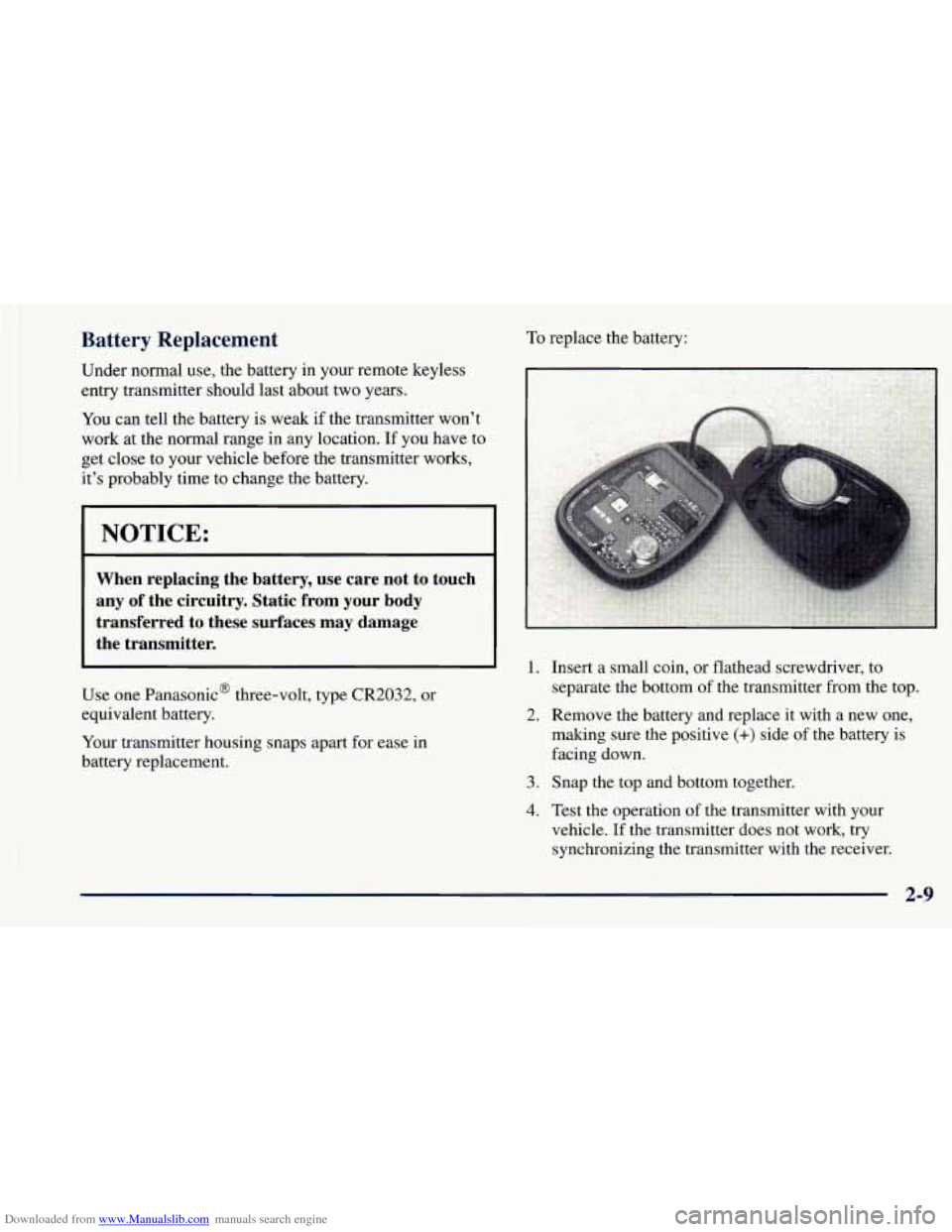
Downloaded from www.Manualslib.com manuals search engine Battery Replacement
Under normal use, the battery in your remote keyless
entry transmitter should last about two years.
You can tell the battery is weak
if the transmitter won’t
work at the normal range in any location. If you have to
get close to your vehicle before the transmitter works,
it’s probably time to change the battery.
NOTICE:
When replacing the battery, use care not to touch
any of the circuitry. Static from your body
transferred to these surfaces may damage
I the transmitter. I
To replace the battery:
L.
Use one PanasonicB three-volt, type CR2032, or
equivalent battery.
Your transmitter housing snaps apart for ease in
battery replacement. 2.
3.
4.
Insert a small coin, or flathead screwdriver, to
separate the bottom
of the transmitter from the top.
Remove the battery and replace it with a new one,
making sure the positive
(+) side of the battery is
facing down.
Snap the top and bottom together.
Test the operation of the transmitter with your
vehicle. If the transmitter does not work, try
synchronizing the transmitter with the receiver.